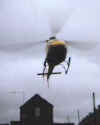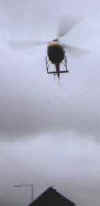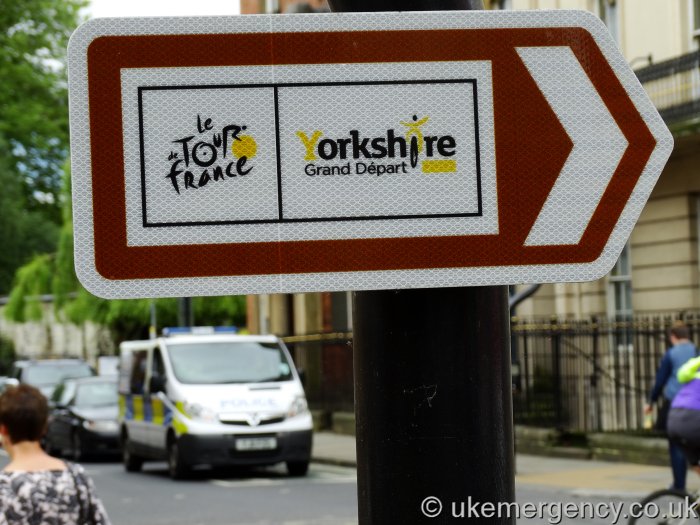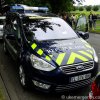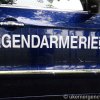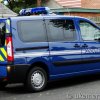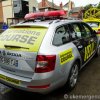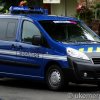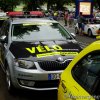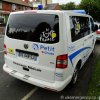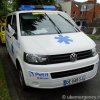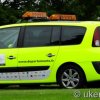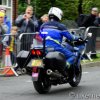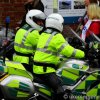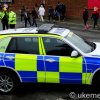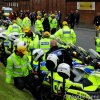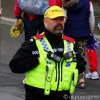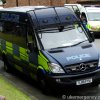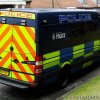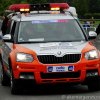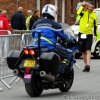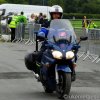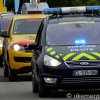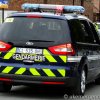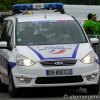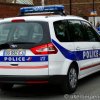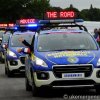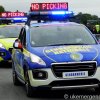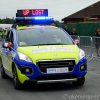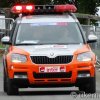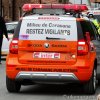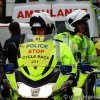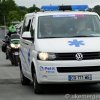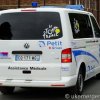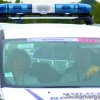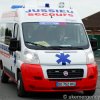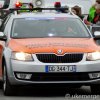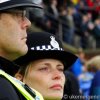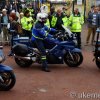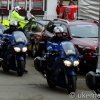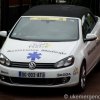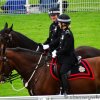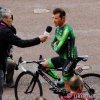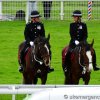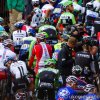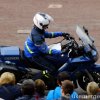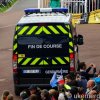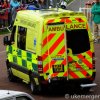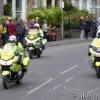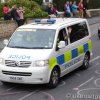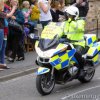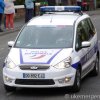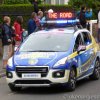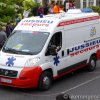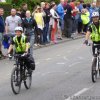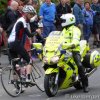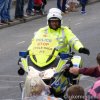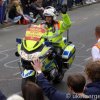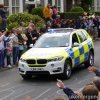Category: Police In Action
Action photos of police officers at an incident or on an exercise
Olympic Torch Relay (2012)
Olympic Torch Relay (2012): Over 70 days during May, June and July 2012, the Metropolitan Police led the Olympic flame around 8,000 miles of the UK assisted by local police forces. The route ended in London where the flame entered the Olympic Stadium and burned throughout the Summer Games.
The reason that such a large escort event was planned: so people could see the Olympic flame close up.
It is rare to see a pillion on a police motorbike, but here we see an Olympic mascot hitching a ride.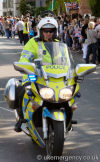
Another of the large number of police motorbikes used.
This West Yorkshire officer offers a high-five to the crowd as he passes. A spirit of fun and approachability was evident from all the police involved, more so than on any normal day.
YD12 ZSU This part of the convoy shows (from foreground to background) a North Yorkshire police motorbike, a Met Police BMW escort car, an Olympic BMW escort car with variable message sing, an Olympic coach carrying torch bearers and finally a truck of dancing people to gee the crowd up.
A closer look at the BMW that was loaned to the Met for the duration of the event.
A closer look at one of the torch relay buses being escorted through the temporarily closed streets.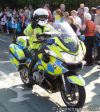
A Met Police officer waving to the crowd as he rides past.
Here are two Met Police officers who run closely alongside the torch bearer. Notice the small Met Police crest on the chest and lack of any personal protective equipment.
More crowd waving as more parts of the convoy approach.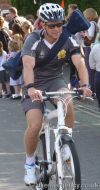
This Met Police officer is using a cycle to escort the torch. On his left arm is a warrant card holder.
In addition to the normal equipment on this police escort bike are a union flag and a water bottle.
The celebratory mood continues as officers park up at the end of the day.
The rear view of the line up of bikes used from various forces supporting the Metropolitan Police.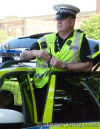
Everywhere the torch went, thousands of photographs were taken. This Humberside officer gets into a vantage point with his camera ready on the roof.
YD12 ZSO A key vehicle is this Met Police BMW X5 that was loaned by Olympic sponsor BMW for the duration of the event.
The side view shows that the Met took the opportunity to advertise their Twitter feed. The car is labelled as ‘BMW TR3’, TR meaning Torch Relay.
The rear view shows the variable message sign that read ‘Olympic Torch Relay Do Not Pass’.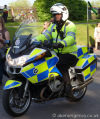
This Humberside bike has gained a green flag for some reason as part of the fun.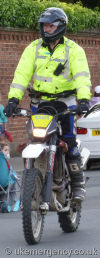
YJ09 EWX Where the Olympic flame was carried across grassland, local forces supplied various means of escorting it including this off road scrambler bike.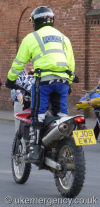
The rear view of the police Husqvarna scrambler bike.
More motorbikes riding in convoy.
This officer ensures the road ahead is clear for the imminent arrival of the torch bearer escort.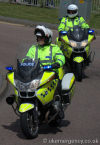
An officer rides at speed ahead of the main convoy. Outside of built up areas, the flame was carried by vehicles before returning to be carried by a running torch bearer.
Protest (2003)
Protest (2003): This article shows the police operations at a 3000-person protest march against war in Iraq in March 2003.
A crowd begins to gather. People mill around in a largely friendly and peaceful manner. The police’s command officers discuss the route and style of the procession with the organisers.
The vehicles leading the march to clear the road ahead. The route lends itself to small vehicles, so this motorbike and police cycle are ideal, backed up by officers on foot.
Two police vans can be seen parked in the background which will be used to follow the march.
Uniformed officers on foot and the police motorbike make their way to the main road. They prepare to stop the traffic to allow the march to join the carriageway.
Uniformed police officers use hand signals to stop the traffic as the motorbike begins to move off, in anticipation of the marchers soon following.
The protesters snake their way along a dual carriageway section of road. Lots of noise, chanting and instrument playing further increase their presence. Some motorists sound their horns either in support or annoyance!
At the half-distance stage, police officers stop the procession to allow the back-markers to catch up. The deafening noise of the marchers reverberates off the tall buildings and brings out hundreds of shoppers, many of whom join in!
The police mountain bike and motorbike continue to lead the group the wrong way through a pedestrianised shopping area. A smaller procession in quickly diverted away from meeting head-on with the main protest by the quick thinking of the leading officers. They use hand signals and sirens to move the smaller procession to one side.
The protest passed off without any arrests. Only one casualty was treated for stumbling on some steps. However, the protests were not very successful as war broke out only a few days later.
Road Traffic Collision (2002)
Road Traffic Collision (2002): This page shows how the emergency services responded to a road traffic collision where a motorcyclist had been knocked off his bike by a car emerging from a side road.
4:58pm One minute after the collision. A police Peugeot Expert has arrived with blue lights flashing. It is positioned to block one side of the road. An ambulance is arriving at the same time as York’s lifecycle paramedic. In the foreground is the motorbike casualty lying on the ground. Paramedics are calming and treating the patient. Eyewitnesses say that the rider stood up after the crash, stumbled around and then fell to the floor.
4:59pm The scene from the opposing view. The severely damaged bike has slid to a stop in the centre of the carriageway. The position of the two emergency vehicles on-scene prevents traffic from passing and hitting the bike.
5:04pm As crowds begin to gather and traffic builds up, more police vehicles arrive with blue lights showing. A Volvo V70 T5 traffic car and a Peugeot 306 panda car stop the traffic before it reaches the ambulance. Officers get out and begin to direct the heavy rush-hour traffic to turn around.
5:08pm The car emerging from the side road is this red Land Rover Discovery. Minor scrapes are noted on the bumper and a significant dent caused by the motorcyclists head on the bonnet. It has been surrounded by ‘police’ tape. It is far too early to appoint blame at this stage.
5:10pm TENYAS’s life cycle, with the crashed bike in the background.
5:14pm More police officers arrive on the scene. The crash site is cordoned off completely while frustrated motorists are shuffled back.
5:16pm Another Volvo V70 T5 and a Ford Explorer have arrived. Traffic officers assist bus drivers to turn their vehicles around.
5:17pm Officers begin to concentrate on the crashed bike. They analyse the scene and record it using the Volvo’s on-board video camera.
5:30pm The officers take measurements and notes about the bike. Debris can be seen scattered across the road. The white container in the foreground is red spray paint, used to mark the tyre routes and final locations of the crashed vehicles.
5:33pm The investigating officers conclude their findings. The police tape is started to be removed and the recovery and clean up operation commences.
7:05pm The road is cleared and all of the police vehicles have left. A small amount of evening traffic passes, oblivious to the action seen just two hours ago. The only indications that this was an accident site are the red paint marks on the road.
The motorcyclist escaped serious injury. He was treated for shock, cuts and bruises in hospital and released the same day. It transpires that he was knocked off his bike as he moved down the side of a queue of stationary traffic. A motorist had left a gap for the Land Rover to emerge from the side road, so it did, crashing into the bike. Officers at the scene were continually distracted from their work by some pedestrians ignoring the ‘police’ tape used to cordon off the crash scene. The tape is used for a good reason, to protect the scene and its evidence, and should not be crossed unless instructed.
Out on Patrol (2002)

Out on Patrol (2002): In this album we are out on patrol with North Yorkshire’s Road Policing Group. This is the patrol car, a Volvo S70, we will be using.
Parked on a flyover, we can carry out speed checks on the traffic below.
Stephen watches the sparse traffic pass by. Traffic officers are easily recognisable in the UK by their white caps.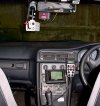
Inside the car is a vast array of equipment. The right hand camera records video footage all of the time. The left hand camera automatically reads registration plates and checks them against the PNC (Police National Computer) records. The system alerts the police officers to any vehicle which is reported as stolen or flagged for any other reason. Radio equipment and speed detection devices can also be seen.
The in-car video recoding system in use. We stop a farmer who is driving the wrong way along a dual carriageway slip road. He was taking a ‘short cut’ with a trailer full of hay. It is suggested that he may be prosecuted for dangerous driving – meaning a large fine and a driving ban.
Stephen walks up the sliproad to get photographic evidence of the route the farmer took. It is clear that the road is designed for one-way traffic by signs and lack of central road markings. During our time here, many HGVs thundered around the corner, gathering speed to merge onto the dual carriageway. If the farmer had met one of them head-on, he and his passenger would be very lucky to survive the crash.
We block the road for a practice stinger deployment. The bed of nails is thrown or dragged across the road to puncture the tyres of a target vehicle. Notice how one stinger can cover an entire dual carriageway.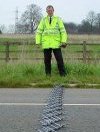
The view across the road with Stephen in the background. He stands clear in case the stinger is whiped up by the fleeing vehicle.
The trellis of hollow spikes can clearly be seen. The device rocks as the vehicle moves over it, ensuring a large number of spikes enter the tyres. It deflates the tyres quickly, bringing the vehicle to a halt in a controlled fashion within a few seconds.
A unit that can back up our Volvo is this Toyota Landcruiser Amazon. It has a 4.7 litre engine that produces 232 bhp and returns about 14 mpg.
The side view of the same vehicle.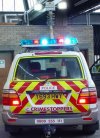
The ‘Nightscan’ floodlight is a special feature of this vehicle. This telescopic pair of floodlights can be raised and pivoted from within the vehicle. They can illuminate a crash scene or a checkpoint.
Another vehicle that can back us up is this VERY fast unmarked Subaru Impreza. It is the STi version and is fitted with blue lights, a camera and a rear matrix sign alongside all the regular police equipment.
Road Traffic Collision (1999)
Road Traffic Collision (1999): A car hits a pedestrian on a dull and wet day in the village of Marley Hill, Tyne and Wear. See how the scene developed and how the emergency services responded.
Two Volvo T5’s race to the scene of the serious RTA with lights and sirens on. The road is wet and they have to make sure they don’t cause or become another accident themselves.
At the scene – mayhem. Emergency vehicles have been abandoned to see to casualties, and traffic on the A692 is quite heavy.
G-NAAS is called in to air lift the casualty who has suspected spinal problems. The North East Air Ambulance is available to respond to any incident in the Northumberland, Tyne and Wear, Durham and Cleveland counties. It has landed in between flower beds on a small piece of public land. Police officers help the paramedics.
Below, the view South. The first vehicle is a Land Rover discovery QRU ambulance (Quick Response Unit). Rarely used for transporting patients, it is used to treat them while waiting for a ambulance, or in this case the air ambulance. To it’s right is the Vauxhall Nova left in situ where it skidded to a stop after the impact. To it’s right is a Volvo traffic police car.
The view North after a couple of minutes. Officers begin to cone off the road, erect ‘Police Accident’ signs and tidy up as well as controlling the traffic.
Below, the air ambulance begins to lift off. The sound and down draft are tremendous.